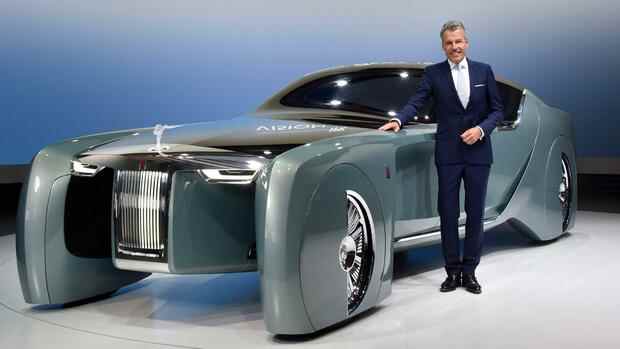The Rolls-Royce boss has to moderate the change from the combustion engine to the electric motor at the luxury brand.
(Photo: BERNHARD_LIMBERGER / BMW Group)
Munich For Torsten Müller-Ötvös it is a “historic step”. At the end of 2023, Rolls-Royce will present its first electric model, from 2030 the brand will only sell electric cars, the brand boss announced on Wednesday. After all, the founding fathers Henry Royce and Charles Rolls would have wanted to build electric cars 100 years ago, since electric drives were already significantly quieter and more efficient than combustion engines back then. The bold plan failed: there was already a lack of charging stations in Victorian England.
Today the British are standing in front of empty gas pumps and Müller-Ötvös wants to bring Rolls-Royce and the electric drive back together. The step into electromobility is long overdue: With the announced ban on the internal combustion engine from 2030, the British government is forcing the industry to change course. After Mini, the second BMW brand, Rolls-Royce, is now putting an end to the combustion engine chapter.
Müller-Ötvös will have to moderate this change. It is likely to be the last major project of the 61-year-old German who has led the British BMW subsidiary for over ten years. For BMW executives, it’s actually over at 60. But the project is too important. The Rolls-Royce boss named the electric limousine “Specter”, which as always will be closely linked to the parent company.
Because just as the BMW 7 Series and the Rolls-Royce sedans shared important components and engines in the past, the “Specter” will also get a lot of Bavarian start-up help. In 2022 BMW wants to bring the “i7” onto the market, the drive train should form the basis for the electric Rolls-Royce. Müller-Ötvös knows: Without the mother from Munich and her technology, the British luxury brand would no longer exist today.
Top jobs of the day
Find the best jobs now and
be notified by email.
But: It must not yet appear that Rolls-Royce is using components from the disdainful world of mass-produced automobiles. “A Rolls-Royce always needs a certain appearance,” explains Müller-Ötvös. He himself embodies the claim perfectly: slim figure, finest thread, best manners. After ten years in the chief post in British exile, it is difficult to tell the difference between a German governor and a British nobleman.
Good feeling for the state of mind of the clientele
This is important in a business where many customers visit the Goodwood headquarters in person. On site, we will gladly clarify again which noble leather and which rare wood should adorn the interior. Or whether the picnic basket can still be put in the trunk for the price of a small car.
Over the years, Müller-Ötvös has built a good feeling for the emotional state of this clientele. “After all, our customers don’t want to see their cars on every street corner.” The risk is manageable. Rolls-Royce has bowed to the zeitgeist and is now also building an SUV with the “Cullinan”. The brand is also very popular with Chinese young millionaires, which is what drives the numbers. But the exclusivity will hardly be damaged. Rolls-Royce will sell just 5,000 cars this year – compared to 2.5 million from the parent brand BMW.
Still, Rolls-Royce is more than an appendage for the Munich car company. You work “very, very profitably,” says Müller-Ötvös, and that also helps the parent company. For years, the BMW strategists have been trying to gain more market share in the luxury segment, because it is there that competitor Mercedes achieves the highest returns in the industry with its S-Class.
If the Munich-based company succeeds in distributing the high development costs between BMW and Rolls-Royce better, the gap between them and their rivals will be smaller. This has already been achieved with the small car subsidiary Mini. The Mini will be built for the first time at the BMW plant in Leipzig from 2023. That is of course out of the question for Rolls-Royce, Goodwood will remain the production site.
Nevertheless, the British luxury subsidiary will continue to be closely managed from Germany in the future. For example, as part of the sustainability strategy that CEO Oliver Zipse has prescribed for the entire company. In the future, all cars are to be designed in such a way that the raw materials can be reused as easily as possible after being scrapped. This is now called “circularity” at BMW headquarters.
A requirement to which Müller-Ötvös has its own answer. “A Rolls-Royce is not scrapped,” explains the brand boss. “80 percent of the Rolls-Royce ever built are still on the road.”
More: Lamborghini, Bugatti, Ferrari – Why the luxury brands have such a hard time with electric cars

